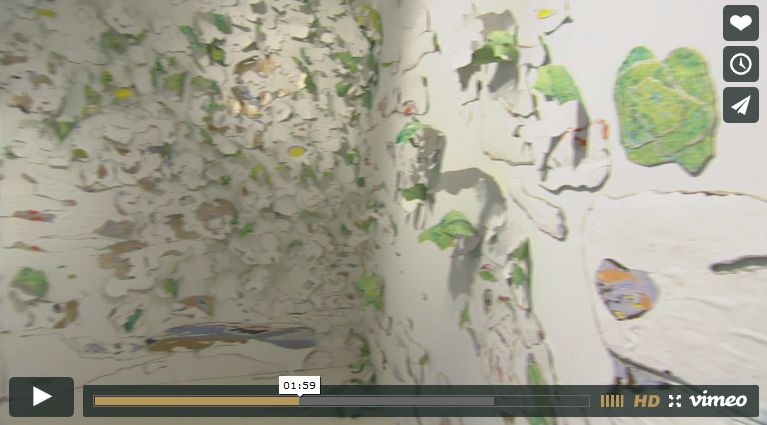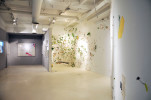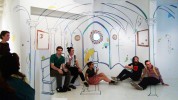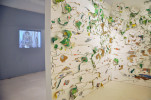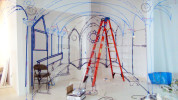Circumferences Reforming: Peel Till They Bloom
TRIAD, Miami, USA
View from outside
Entrance
Animated Fra Angelico fresco
Layered drawings and the reverse side of Fra Angelico fresco
Layered Drawings
Detail: Layered drawing
Installation view
Installation view: fractured illusion of the Fra Angelico church image
Installation view: aligned illusion of the Fra Angelico church image. Viewer watching herself in projection.
Installation view: aligned illusion of the Fra Angelico church image.
Viewers watching themselves onscreen in the aligned illusion of the Fra Angelico’s church.
Opening night
Installation view
Installation view
Installation view
Detail: Peel till they Bloom
Installation view
Detail: micro-interventions
Drawing
Detail: Animation screen embedded in wall
Fractured illusion of the Fra Angelico’s church and aligned view seen in projection.
Fractured illusion of the Fra Angelico’s church and aligned view seen in projection.
Fractured illusion of the Fra Angelico’s church and aligned view seen in projection.
Fractured illusion of the Fra Angelico’s church and aligned view seen in projection.
Detail: colored plaster and collage
Detail: colored plaster and collage
Detail: colored plaster and collage
Viewers watching themselves onscreen in the aligned illusion of the Fra Angelico’s church.
Viewers watching themselves onscreen in the aligned illusion of the Fra Angelico’s church.
Viewers watching themselves onscreen in the aligned illusion of the Fra Angelico’s church.
Process of mapping the illusion
Process of mapping the illusion
Process of mapping the illusion
Process of mapping the illusion
Project Description: The image of a Fra Angelico fresco comes to life in the window animated with moving angels and deteriorating churches. A 3d illusion of the same church is drawn with colored plaster on various surfaces in the gallery, and viewers see themselves in a projection, entering this image, becoming a character in the painting. The show also featured installations with layered paper, tiny sculptures in polymer clay, collaged images and layered paper drawings.
Circumferences Reforming: Peel till they Bloom
Buena Vista Building Unit 222 180 NE 39th Street Design District, Miami
By Veeranganakumari Solanki
The illusions of permanence, fixity and the constant are within the knowledge of the seen and the acknowledgments of the unnoticed. They pair with the comfort of the known to manifest into an ephemeral space of shifting visions and vantage points in Sumakshi Singh’s “Circumferences Reforming: Peel till they Bloom”. In this series, the artist creates a merger of tangents from “Circumferences Forming”, “Peel till they Bloom”, her micro-interventions, perceptual mappings of illusionary spaces upon physical spaces and layered paper drawings. These surfaces expand and merge into new languages, which challenge each other to create unique and invented junctures of interaction and relationship with the viewers, the space and other works in the exhibition. The frames spill into the undefined and hidden unknown spaces, to question the known constantly. Skewed geometric angles align themselves with unidentified starting points from the interiors of another place, to challenge the viewer’s perception of defined spaces physically inhabited with their bodies. The images move behind hidden layers of the wall, only to reappear in another section of the space to converse with another visitor; and indefinite sculptural blobs become beautiful micro-worlds on close inspection.
A large archway is a window to the past, where there is still a lurking animated movement, which creates a sense of the unknown. From a distance, one peers into a familiar imagery of a well known Renaissance depiction of an annunciation scene. This merges into an obscure European church with similar architecture within this arched window at Bueno Vista in Miami. Here, in Singh’s renewed vision, the frescoes flake and begin to move and merge into drawn images; thereby taking on subjective meaning and forms of knowledge and vision, in the viewer’s mind. The passage of the animation follows a shaft of sunlight as it traverses the church and fades back into the fourteenth century frescoes. The elusive knowledge that one has of the past begins to peel away in a manner similar to this work. It partially reveals buried facts that will not allow the viewer to grasp it in its entirety. Singh constantly refers the virtual and multiple reality of her work to Maya; saying that it “traverses the lines between Metaphor, Reality and Illusion”.
This stirring notion takes on another metaphor in the artist’s watercolours and the layered drawings. One encounters a tangible aspect of the moving images behind this tinted skin into which Singh breathes in her micro-interventions. Etched graffiti traced from the ancient walls of Mughal monuments are embedded within this contemporary space on multiple layers of painted paper; and patterns play with the malleable mind. These create new perceptions and renewed visions of the past, of the details in nature and the ongoing personal contemporary phenomena. Curious layers peel away to create an imagined awareness of the sense of movement within these references of history and details that are to follow. There is a reflection of microcosmic elements that derive their silhouettes from organic forms in nature.
These appearances explode into the stretch of Singh’s Peel Till They Bloom, as they break the boundaries of a framed work to re-form circumferences from other elements in the exhibition, while also creating a new version of trained seeing and looking for the viewer. The work questions the notion of territory, by demanding attention of vision from the viewer, to embed into their minds, micro-interventions of thought processes. The outburst gradually becomes subtle into the artist’s “contained pockets of activity” in the “living membranes” of animation embedded in the wall.
Describing these micro-interventions, Singh addresses the acceptance of flaws (by creating beautiful fractured wall) for appreciation of nature outside of the realm of urban perfection, while providing the suggestion of a “space-time hiccup”. There is a universal understanding and translation of the Tower of Babel with the willingness to discover and participate. However, the artist accurately mentions that these micro-interventions “resist efficiency in viewing, decoding and digesting, as it becomes impossible to decide what is the art and what isn’t.”
Singh constantly involves the viewers’ gaze in the space, as she progressively begins to disperse the micro-interventions into niches and places below or above eye-level. This translates into an anti-thesis of the otherwise granted ease of life, gaining, viewing and comfort.
Just as one gets accustomed to this “peripheral vision” of mushrooming blooms of micro-interventions, they find that the frescoes of the European church from the window have migrated into a projection, which they find themselves a part of, along with borrowed visions from other outside elements. This work binds the exhibition together, creating a full circle, where tangents are never constant. The sensations of consciousness and unconsciousness become blurred while trying to create an understanding of the free movement of images below the skin of the wall; and then eventually between the outside and the inside; the real-space and the mind-space. As one tries to seize the dialogue of the reality of illusions within the shedding nature of these stitched walls, there is a realisation of conscious awareness and personal space.
By creating several centres, Singh ensures that there is a constantly shifting point of focus and vision. The changing view and landscape of the works activate themselves into a space that silently transforms the inside to the outside and vice versa. One grapples with a realisation of the importance of minute details, when the most indefinite and abstract shapes appear beautiful, as they peel to bloom. The artist also subtly plays with the fragility of phenomena, perceptions and personal that is experienced through her works. Addressing her primary concerns of this body of work, Singh refers to is as “an investigation through the non-linear filter of art making of: What is permanent and unchanging? What is real and how do we recognize it? History is no longer seen as a recounting of fact. It is increasingly hard to locate the ‘real’, the ‘fixed’ and the ‘certain’.”
From tiny fractures in the wall, to peeling layers of wall surfaces, these amoeboid, amorphous and occasionally fractured, rectilinear shapes shed away all pre-conceived notions to bloom into a new world of reformed circumferences that leave centres everywhere.
Micro-Interventions
2012:
TRIAD, Miami, USA
2011:
MAXXI museum, Rome, Italy
MAC museum, Lyon, France
2008:
Galerie Kashya Hildebrand, Zurich, Switzerland
2006:
Van Harrison Gallery, New York, USA
2004:
Museum of Contemporary Art, Chicago, USA
2003:
Gallery 400, Chicago, USA
2003 - 2009:
Illinois State Museum and others, USA





































